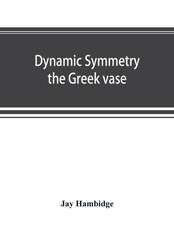The Elements of Dynamic Symmetry: Dover Art Instruction
Autor Jay Hambidge, Art Instructionen Limba Engleză Paperback – 31 mai 1967
Din seria Dover Art Instruction
- 15%
 Preț: 82.45 lei
Preț: 82.45 lei - 15%
 Preț: 86.92 lei
Preț: 86.92 lei - 15%
 Preț: 79.93 lei
Preț: 79.93 lei - 15%
 Preț: 86.84 lei
Preț: 86.84 lei - 14%
 Preț: 83.42 lei
Preț: 83.42 lei -
 Preț: 113.39 lei
Preț: 113.39 lei - 16%
 Preț: 40.46 lei
Preț: 40.46 lei - 14%
 Preț: 69.22 lei
Preț: 69.22 lei - 16%
 Preț: 53.42 lei
Preț: 53.42 lei - 14%
 Preț: 69.31 lei
Preț: 69.31 lei - 16%
 Preț: 45.36 lei
Preț: 45.36 lei -
 Preț: 206.07 lei
Preț: 206.07 lei - 16%
 Preț: 66.10 lei
Preț: 66.10 lei - 16%
 Preț: 67.45 lei
Preț: 67.45 lei - 15%
 Preț: 91.91 lei
Preț: 91.91 lei -
 Preț: 91.14 lei
Preț: 91.14 lei -
 Preț: 89.06 lei
Preț: 89.06 lei -
 Preț: 42.85 lei
Preț: 42.85 lei -
 Preț: 84.32 lei
Preț: 84.32 lei -
 Preț: 44.53 lei
Preț: 44.53 lei -
 Preț: 50.51 lei
Preț: 50.51 lei -
 Preț: 91.14 lei
Preț: 91.14 lei -
 Preț: 78.51 lei
Preț: 78.51 lei -
 Preț: 126.59 lei
Preț: 126.59 lei -
 Preț: 109.91 lei
Preț: 109.91 lei -
 Preț: 52.55 lei
Preț: 52.55 lei -
 Preț: 78.34 lei
Preț: 78.34 lei -
 Preț: 73.97 lei
Preț: 73.97 lei -
 Preț: 60.40 lei
Preț: 60.40 lei - 14%
 Preț: 69.39 lei
Preț: 69.39 lei - 13%
 Preț: 97.51 lei
Preț: 97.51 lei - 15%
 Preț: 106.55 lei
Preț: 106.55 lei -
 Preț: 27.79 lei
Preț: 27.79 lei -
 Preț: 47.64 lei
Preț: 47.64 lei -
 Preț: 79.33 lei
Preț: 79.33 lei -
 Preț: 70.10 lei
Preț: 70.10 lei -
 Preț: 56.61 lei
Preț: 56.61 lei -
 Preț: 91.47 lei
Preț: 91.47 lei - 16%
 Preț: 77.26 lei
Preț: 77.26 lei - 21%
 Preț: 73.50 lei
Preț: 73.50 lei - 16%
 Preț: 105.32 lei
Preț: 105.32 lei -
 Preț: 80.92 lei
Preț: 80.92 lei
Preț: 72.15 lei
Nou
13.81€ • 14.41$ • 11.43£
Carte disponibilă
Livrare economică 15-29 martie
Specificații
ISBN-10: 0486217760
Pagini: 174
Dimensiuni: 136 x 220 x 12 mm
Greutate: 0.24 kg
Ediția:Dover.
Editura: Dover Publications
Seria Dover Art Instruction
Textul de pe ultima copertă
Is design intuitive or is it consciously and methodically worked out? Are there basic rules governing design that, when learned, will facilitate the creative process? These questions have been asked by artists, art historians, and art critics throughout the ages.
Convinced that design was not purely instinctive, Jay Hambidge (1867 1924) spent much of his life searching for the technical bases of design. He found his answer in dynamic symmetry, one of the most provocative and stimulating theories in art history. Hambidge's study of Greek art convinced him that the secret of the beauty of Greek design was in the conscious use of dynamic symmetry the law of natural design based upon the symmetry of growth in man and in plants. But Hambidge, who was not only a theoretician but also a practicing artist, did much more than analyze classical art and its principles of design: he worked out a series of root rectangles that the artist, using the simple mathematics supplied in this book, can easily follow and apply in his own work.
Originally published as a series of lessons in Hambidge's magazine, The Diagonal, this engrossing book explains all the basic principles of dynamic symmetry. Part I sets forth the fundamental rectangles with their simple divisions based on the proportioning law found in nature; Part II explains compound rectangles, many of which were taken from or suggested by analysis of objects of Greek art.
Whether read for its historical importance in art theory, for its illuminating insights into Greek art, or for its practical value to today's artists and commercial designers, The Elements of Dynamic Symmetry has much to offer anyone who is interested in the principle of design.
Dover republication of the third (1948) edition."




















